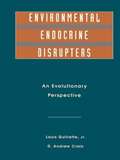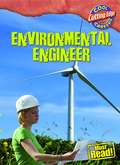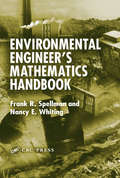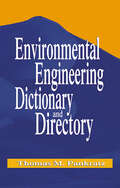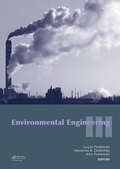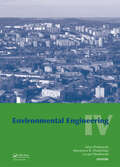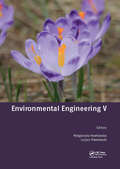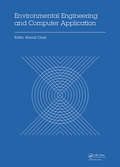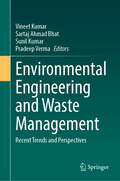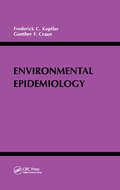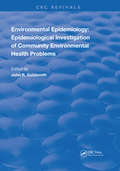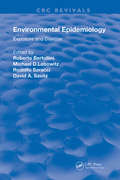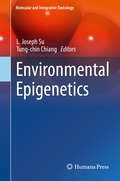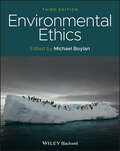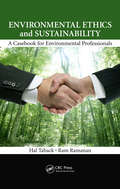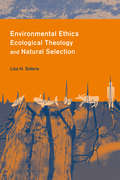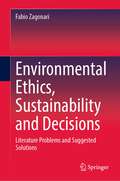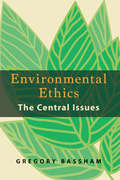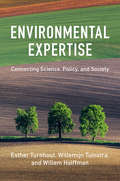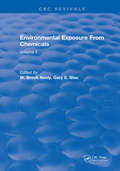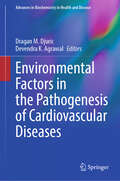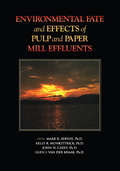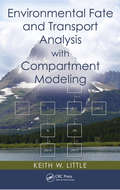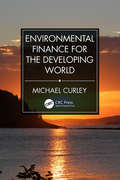- Table View
- List View
Environmental Endocrine Disruptors: An Evolutionary Perspective
by Jr. Louis J. Guillette D. Andrew CrainAddresses many aspects of endocrine disruption by environmental encountered toxic substances. Initial chapters provide essential background information whilst later chapters address specific aspects of endocrine disrupting contaminants (EDC)
Environmental Engineer (Cool Cutting Edge Careers)
by Geoffrey M. HornHow can we keep our drinking water pure? Whats the best way to dispose of our waste? How can we limit pollution? Answering these questions is the job of environmental engineers. Using the latest technology and research, environmental engineers are changing our world. Learn about the many different jobs that make up this cutting-edge career.
Environmental Engineer's Mathematics Handbook: Null
by Frank R. Spellman Nancy E. WhitingAdvanced mathematics used in engineering is studied here in this text which examines the relationship between the principles in natural processes and those employed in engineered processes. The text covers principles, practices and the mathematics involved in the design and operation of environmental engineering works. It also presents engineering
Environmental Engineering Dictionary and Directory
by Thomas M. PankratzLike most technical disciplines, environmental science and engineering is becoming increasingly specialized. As industry professionals focus on specific environmental subjects they become less familiar with environmental problems and solutions outside their area of expertise. This situation is compounded by the fact that many environmental science
Environmental Engineering III
by Lucjan Pawłowski Marzenna R. Dudzińska Artur PawłowskiEnvironmental engineering has a leading role in the elimination of ecological threats, and can deal with a wide range of technical and technological problems due to its interdisciplinary character. It uses the knowledge of the basic sciences � biology, chemistry, biochemistry and physics � to neutralize pollution in all the elements of the environm
Environmental Engineering IV
by Artur Pawłowski, Marzenna R. Dudzińska & Lucjan PawłowskiEnvironmental engineering has a leading role in the elimination of ecological threats, and deals, in brief, with securing technically the conditions which create a safe environment for mankind to live in. Due to its interdisciplinary character it can deal with a wide range of technical and technological problems. Since environmental engineering use
Environmental Engineering V
by Lucjan Pawłowski Małgorzata PawłowskaPoland, like other post-communist countries, is undergoing a transformation into a capitalist system. This transformation affects the country in many ways: economic, social, psychological and also ecological. Ecological problems are strongly connected with the political, economic and psychological inheritance of the past, as well as with changes in the post-communist society. In order to understand these problems, it is necessary to consider the following issues:- the geographic situation of Poland - the political transformations that occurred after World War II – forced development of heavy industry combined with neglect of its effects on the environment, and - the economic problemsThe three main goals of Environmental Engineering V are (I) to assess the state of scientific research in various areas of environmental engineering. (II) to evaluate organizational, technical and technological progress in contributing to ecological security, and (III) to determine the place of environmental engineering in sustainable development, taking into account political and economic conditions. Environmental Engineering V is of interest for academics, engineers and professionals involved in environmental engineering, seeking solutions for environmental problems in emerging new democracies, especially those who plan to participate in numerous projects sponsored by the European Union.
Environmental Engineering and Computer Application: Proceedings of the 2014 International Conference on Environmental Engineering and Computer Application (ICEECA 2014), Hong Kong, 25-26 December 2014
by Kennis ChanThe awareness of environment protection is a great achievement of humans; an expression of self-awareness. Even though the idea of living while protecting the environment is not new, it has never been so widely and deeply practiced by any nations in history like it is today. From the late 90s in the last century, the surprisingly fast dev
Environmental Engineering and Waste Management: Recent Trends and Perspectives
by Sunil Kumar Vineet Kumar Sartaj Ahmad Bhat Pradeep VermaThis book presents fundamental principles and recent advancements in managing waste in an environmentally sustainable manner. It explores a wide array of methods and technologies designed to transform waste, thereby reducing health impacts across various stages such as waste minimization, transportation, handling, storage, and disposal of solid wastes. Moreover, the book delves into waste-contaminated site assessment methods, environmental issues and impacts, as well as the latest regulatory and policy statutes. The inclusion of case studies allows for the assessment of diverse waste management challenges, showcasing how environmental engineering methods can be applied to process industrial waste sustainably. For instance, certain sections of the book delve into the intricate microbial communities and their metabolic pathways, illustrating their role in the remediation and management of municipal waste at landfill sites. This book caters to a broad audience, including teachers, researchers, practitioners, environmental engineers, chemical engineers, soil scientists, policymakers, and students specializing in environmental engineering, chemical engineering, environmental biotechnology, and environmental science.
Environmental Epidemiology
by Frederick C. KopflerThis informative book is valuable to a broad spectrum of individuals active in the environmental and health sciences, including chemists, epidemiologists, and mathematics modelers, as well as those involved with measurement and effects of numerous kinds of drinking water contamination and both indoor and ambient air pollution. Environmental researchers involved with human exposure to toxic substances, regulators and administrators will also find this work of value.
Environmental Epidemiology: Epidemiology Investigation of Community Environmental Health Problems (Routledge Revivals)
by John R. GoldsmithPublished in 1986: This book tells the story of how various persons and groups have successfully dealt with a type of problem which may threaten the lives and health of every group of humans – every community. The problem is that of a polluted environment.
Environmental Epidemiology: Exposure and Disease (Routledge Revivals)
by M. P. H. Fccp Roberto Bertollini Michael D. Lebowitz Face Rodolfo Saracci David A. SavitzPublished in 1996: Environmental Epidemiology: Exposure and Disease is a unique resource identifying priorities for public health research in selected areas of environmental epidemiology. Drawn from the proceedings of an international workshop on this topic, the book is a compilation of the specialized knowledge and opinions of environmental epidemiology experts. Organized by the Rome division of the World Health Organization (WHO) European Centre for Environment and Health, the goal of the 1993 workshop, Setting Priorities in Environmental Epidemiology, was to establish a consensus among the experts in the selected areas. The chapters in Environmental Epidemiology: Exposure and Disease cover environmental epidemiology from three different viewpoints: environmental exposures, major disease groups related to the environment, and epidemiological methodology. The environmental exposure categories examined for prioritizing are air contaminants, water contaminants, and ionizing and non-ionizing radiation exposure from human-caused disasters. .
Environmental Epigenetics
by L. Joseph Su Tung-Chin ChiangThis book examines the toxicological and health implications of environmental epigenetics and provides knowledge through an interdisciplinary approach. Included in this volume are chapters outlining various environmental risk factors such as phthalates and dietary components, life states such as pregnancy and ageing, hormonal and metabolic considerations, and specific disease risks such as cancer cardiovascular diseases, and other non-communicable diseases. Environmental Epigenetics imparts integrative knowledge of the science of epigenetics and the issues raised in environmental epidemiology. This book is intended to serve both as a reference compendium on environmental epigenetics for scientists in academia, industry, and laboratories and as a textbook for graduate level environmental health courses. Environmental Epigenetics imparts integrative knowledge of the science of epigenetics and the issues raised in environmental epidemiology. This book is intended to serve both as a reference compendium on environmental epigenetics for scientists in academia, industry, and laboratories and as a textbook for graduate level environmental health courses.
Environmental Ethics
by Michael BoylanThe latest edition of an essential resource in the theory and applications of environmental ethics In the newly revised Third Edition of Environmental Ethics, internationally renowned philosopher Michael Boylan delivers another accessible introduction for students new to ethics, and an invaluable reference for scholars of all levels. The anthology includes important essays, both established and contemporary, as well as eight brand-new contributions commissioned specifically for this edition. This new material is the foundation for students# understanding of the most recent ethical debates on the environment and humanity's place within it. The balanced combination of new material on recent developments in the field and well-known, foundational articles appears alongside helpful pedagogical materials, including case studies and sample questions. The book brings students up to speed on all the main themes in the area, including worldview arguments for environmentalism, the anthropocentric vs. biocentric debate, and a variety of applied environmental problems. Environmental Ethics also offers: A thorough introduction to the theoretical background of environmental ethics, including discussions of ethical reasoning, nature, and the tragedy of the commons Comprehensive explorations of eco-feminism and social justice, aesthetics, and deep ecology Practical discussions of anthropocentric and biocentric justifications in environmental ethics In-depth examinations of applied environmental problems, including climate change, animal rights, sustainability, and public policy Perfect for undergraduate and graduate students studying topics in ethics, the environment, law, and policy, Environmental Ethics will also earn a place in the libraries of philosophers with an interest in applied or environmental ethics, and industry consultants to ecologists, environmental scientists, or environmental policymakers.
Environmental Ethics and Sustainability: A Casebook for Environmental Professionals
by Hal Taback Ram RamananThe environmental professional must be educated to be ethical, and more importantly, trained through frequent participatory workshops with real-world scenarios to be able to make the right choices when faced with environmental dilemmas. This book serves as a reference and a resource casebook, presenting current real-world situations and providing perspectives to numerous environmental ethics scenarios. It provides specific guidance as to what is ethical behavior, how to judge it, and the foundations of ethical behavior in facing and resolving environmental ethical dilemmas.
Environmental Ethics, Ecological Theology, and Natural Selection: Suffering and Responsibility
by Lisa SiderisLisa Sideris proposes a new way of thinking about the natural world, an environmental ethic that incorporates the ideas of natural selection and values the processes rather than the products of nature. Such an approach encourages us to take a minimally interventionist approach to nature. Only when the competitive realities of evolution are faced squarely, Sideris argues, can we generate practical environmental principles to deal with such issues as species extinction and the relationship between suffering and sentience.
Environmental Ethics, Ecological Theology, and Natural Selection: Suffering and Responsibility (Columbia Series in Science and Religion)
by Lisa SiderisIn the last few decades, religious and secular thinkers have tackled the world's escalating environmental crisis by attempting to develop an ecological ethic that is both scientifically accurate and free of human-centered preconceptions. This groundbreaking study shows that many of these environmental ethicists continue to model their positions on romantic, pre-Darwinian concepts that disregard the predatory and cruelly competitive realities of the natural world. Examining the work of such influential thinkers as James Gustafson, Sallie McFague, Rosemary Radford Ruether, John Cobb, Peter Singer, and Holmes Rolston, Sideris proposes a more realistic ethic that combines evolutionary theory with theological insight, advocates a minimally interventionist stance toward nature, and values the processes over the products of the natural world.
Environmental Ethics, Sustainability and Decisions: Literature Problems and Suggested Solutions
by Fabio ZagonariThis book provides a summary of the main concepts involved in environmental ethics, sustainability and decisions and a consistent sequence of environmental ethics, sustainability and decisions. It presents many environmental ethics, by focusing on maximising welfare within teleological approaches and minimising inequalities within deontological approaches. It presents many sustainability paradigms, by focusing on weak sustainability to maximise welfare and strong sustainability to minimise inequalities. Two main decisions are presented by focusing on policies (taxes, standards, subsidies, permits, protected areas, exploitation rights) and projects (CBA) towards efficiency to maximise welfare and policies (national laws/regulations, bilateral/multilateral agreements) and projects (MCA) towards equity to minimise inequalities.
Environmental Ethics: The Central Issues
by Gregory BasshamEnvironmental Ethics provides an accessible, lively, and up-to-date introduction to the central issues and controversies in environmental ethics. Requiring no previous knowledge of philosophy or ethical theory, the book will be of interest to students, environmental scientists, environmental policy makers, and anyone curious to know what philosophers are saying today about the urgent environmental challenges we face. The book is divided into two parts.Part One deals with theoretical issues in environmental philosophy, examining a variety of ethical and environmental theories that provide diverse and thought-provoking perspectives on critical ecological issues. Part Two turns to applied environmental ethics, addressing current debates on topics such as climate change, biodiversity loss, wilderness preservation, responsibilities to future generations, population growth, overconsumption, food ethics, and ecological activism. Features include: Clear explanations of key concepts and theories that lie at the heart of current debates in environmental ethics. A mix of theory of practice that permits readers to apply diverse theoretical perspectives to key environmental debates. A wealth of pedagogical aids, including chapter summaries, discussion questions, suggested readings, and a glossary of important terms.
Environmental Expertise: Connecting Science, Policy and Society
by Esther Turnhout Willemijn Tuinstra Willem HalffmanAn important goal of environmental research is to inform policy and decision making. However, environmental experts working at the interface between science, policy and society face complex challenges, including how to identify sources of disagreement over environmental issues, communicate uncertainties and limitations of knowledge, and tackle controversial topics such as genetic modification and the use of biofuels. This book discusses the problems environmental experts encounter in the interaction between knowledge, society, and policy on both a practical and conceptual level. Key findings from social science research are illustrated with a range of case studies, from fisheries to fracking. The book offers guidance on how to tackle these challenges, equipping readers with tools to better understand the diversity of environmental knowledge and its role in complex environmental issues. Written by leading natural and social scientists, this text provides an essential resource for students, scientists and professionals working at the science-policy interface.
Environmental Exposure From Chemicals: Volume II
by W. Brock NeelyThis two-volume series will describe the mechanisms that are operating on chemicals as thy move in the environment. Knowledge of these mechanisms is a vital component in performing a risk assessment. Volume I will deal with the physical and chemical properties of a material and how these influence the degradation and dissipating reactions. Volume 2 will address the transport of the chemical as it moves through the environment from the source to the final sink.
Environmental Factors in the Pathogenesis of Cardiovascular Diseases (Advances in Biochemistry in Health and Disease #30)
by Devendra K. Agrawal Dragan M. DjuricEnvironmental conditions and processes are one of the major pillars on which the human well-being rests. It is the core responsibility of the society to preserve and enhance better conditions for the human well-being. Indeed, there are several evolving unmet needs in public health. Emerging and re-emerging infectious diseases and a surge in the incidence of non-communicable diseases, including cardiovascular diseases (CAD), chronic respiratory diseases, and metabolic diseases have been impediments to sustainable well-being. Many factors are critical in the global surge in the rate and incidence of cardiovascular diseases. These include the shift from acute to chronic conditions, the shift from single risk factor vs. multiple influences, aging population, global health disparities, exposure to lower harmful influences over a longer period, etc. However, the epigenetic factors due to unhealthy environment play a most significant role in the underlying pathogenesis of cardiovascular diseases. Unfortunately, this has been ignored for a long time and realized lately to expand and disseminate knowledge to general population, expand research activities to investigate the cellular and molecular mechanisms, and develop better preventive and treatment strategies. The most significant environmental impoverishment in the pathogenesis of cardiovascular diseases include different genetical, chemical, physical, and biological influences, but not limited to, socio-economic status and lack of nutrients, nutritional aspects including habits, diets and additives, inhaled and ingested pollutants, exhaust gas and gasoline products, tobacco smoke, water pollution, alcohol consumption, soil and mineral pollution, solvents, pesticides, microplastics, non-critical usage of drugs, climate change, extreme atmospheric conditions, extremes in noise and temperature, electromagnetic influences, microwaves and radiation, outdoor light pollution, mental stressors, lack of or over exercise, microbiota and microbiological agents like SARS CoV-2 virus, etc.
Environmental Fate and Effects of Pulp and Paper: Mill Effluents
by Mark R. ServosIn recent years, there have been emerging concerns regarding the fate and effects of pulp and paper mill effluents on the environment. Countries throughout the world are focusing attention on the implementation of regulatory and monitoring programs. In response, industry has begun to implement a variety of process and treatment technologies designed to minimize or eliminate the potential impacts.Environmental Fate and Effects of Pulp and Paper Mill Effluents explores the most active and critical current research and experimentation from around the world. This comprehensive overview examines the identity and origin of chemicals in pulp mill effluents, environmental fate of chemicals from pulp and paper mills, bioaccumulation of substances from pulp mills to fish and wildlife, field and laboratory studies of biochemical and whole organism responses associated with pulp and paper effluents, integrated monitoring and future research, and policy directions of this rapidly evolving field.Written by prominent scientists from around the world with contributions from industry, government, and academia, this important new book provides a balanced global perspective of the recent scientific findings and the challenges being faced in the immediate future.
Environmental Fate and Transport Analysis with Compartment Modeling
by Keith W. LittleEnvironmental Fate and Transport Analysis with Compartment Modeling explains how to use the powerful, highly flexible, and intuitive compartment approach to estimate the distribution of chemical contaminants in environmental media in time and space. Add this Easy-to-Use Approach to Your Environmental Modeling ToolboxThis numerical technique enables
Environmental Finance for the Developing World
by Michael CurleyFinancing the Global Environment examines the financial techniques and strategies necessary to obtain funding to undertake infrastructure and environmental projects. Despite conventional notions that monies are typically not readily available for large-scale environmental projects, the book explains how this is usually not the case, and will provide the necessary steps, tools, and organizational methods necessary for successful project finance in any region. It demonstrates how the largest possible projects could be undertaken at the lowest possible cost and how a utility’s excess operating income could be used to improve the system. Features: Presents methods for the sourcing of funds and for maximizing income Defines what types of income can be used for making debt service payments and how it can be estimated Explains the basic concepts of loans and debt, as well as the present value theory of money This book serves as a useful guide for practicing professionals, industry executives, and government officials who work with water and wastewater utilities and infrastructure and are involved with financial project preparation.
